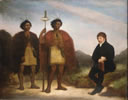Mission schools and the arrival of literacy
The first school along European lines for Māori in New Zealand was established by the missionary Thomas Kendall of the Anglican Church Missionary Society, at Rangihoua, in the Bay of Islands, in 1816. Kendall used rote learning to teach basic reading and writing, and also included religious instruction. Reports suggest that he had difficulty in keeping his charges fully engaged in their learning, and the school ran effectively only when he could provide them with food. Lessons were held in the early morning and late afternoon, with the pupils spending the rest of the day foraging. Kendall developed the first published books in the Māori language to use in his classroom. Kendall’s school only lasted two years, but by the 1830s there were numerous schools attached to mission stations, including those of Methodists from 1822 and Catholics from 1838.
Maussie schools
The first school for Māori was actually in Australia. It was established by Anglican missionary Samuel Marsden at his home in Parramatta, Sydney, from around 1813. In 1820 Marsden was instructing 25 young Māori in the ‘customs and manners of civilized life’.1
Interest in literacy
Māori became increasingly interested in learning to read and write. While the missionaries saw literacy as the key to the scriptures, Māori were more interested in understanding the new European world with its tall sailing ships, firearms and iron tools. Māori who had attended the schools returned to their villages and created their own schools. When George Clarke, a missionary and the chief protector of aborigines, travelled through Waikato and Hauraki in late 1840 he found a Māori-run school in nearly every village he visited. It is estimated that by the early 1840s half of the adult Māori population was able to read and write to some extent. All teaching was in Māori and, because of a lack of reading material other than the scriptures, Māori interest in the schools declined after the early 1840s.
Books for all
William Colenso had established a printing press at Paihia, in the Bay of Islands, in 1834 and printed millions of pages over the following years. By 1845 there was a bible or prayer book for each member of the adult Māori population.
Grey and Māori education
George Grey, governor of New Zealand from 1845 to 1853 and again from 1861 to 1868, was the architect of the government’s racial amalgamation policy in the early colonial period. The effect, however, was more like assimilation, and this was the dominant theme in Māori education policy until the 1930s. The prevailing belief at the time was of the superiority of British civilisation. It was thought that the greatest favour that could be bestowed on Māori would be to turn them into ‘brown Britons’. There had been open warfare with Māori in the mid-1840s and education was seen as a way of pacifying Māori. There is evidence too that the government saw in Māori a potential labouring class to help build the young colony.
Education Ordinance 1847
Running a cash-strapped administration, Grey supported the existing network of mission schools through the Education Ordinance 1847, based on four principles:
- religious instruction
- industrial training
- instruction in the English language
- government inspection.
Native Schools Act 1858
The Native Schools Act 1858 built on this system, providing for an annual sum of £7,000 for the schools, and added the stipulation that Māori students at the schools must live away from their kāinga in a boarding situation. By 1851 between 700 and 800 Māori attended the government-supported schools, considerably fewer than the numbers attending mission schools in the 1830s. Progress was limited with regard to the teaching of English and the government struggled to find the finances to resource the schools appropriately. Many schools continued to teach in Māori. Most of the mission schools were closed by the wars of the 1860s.




